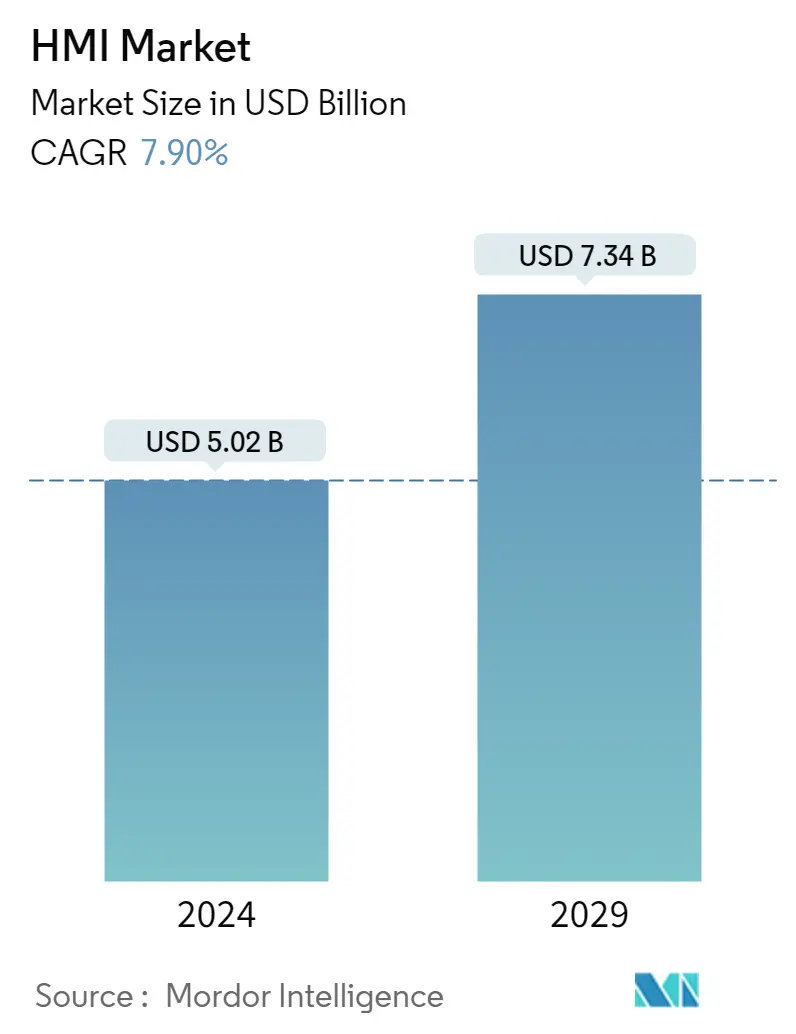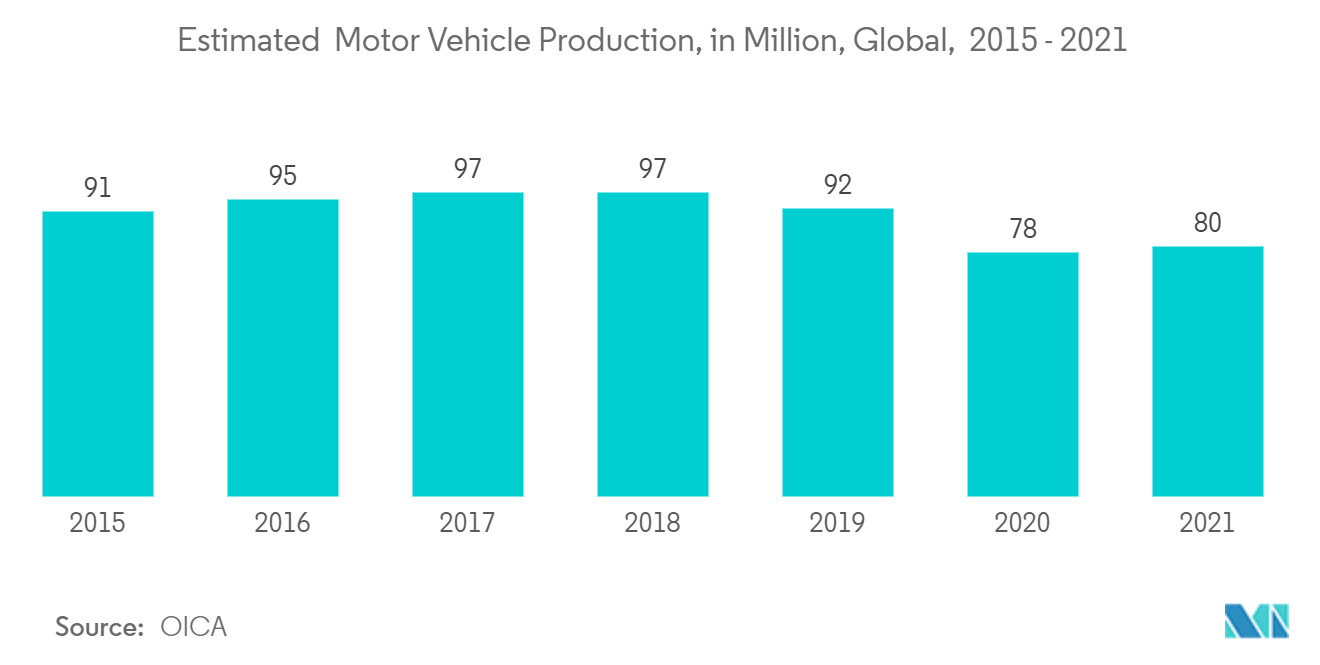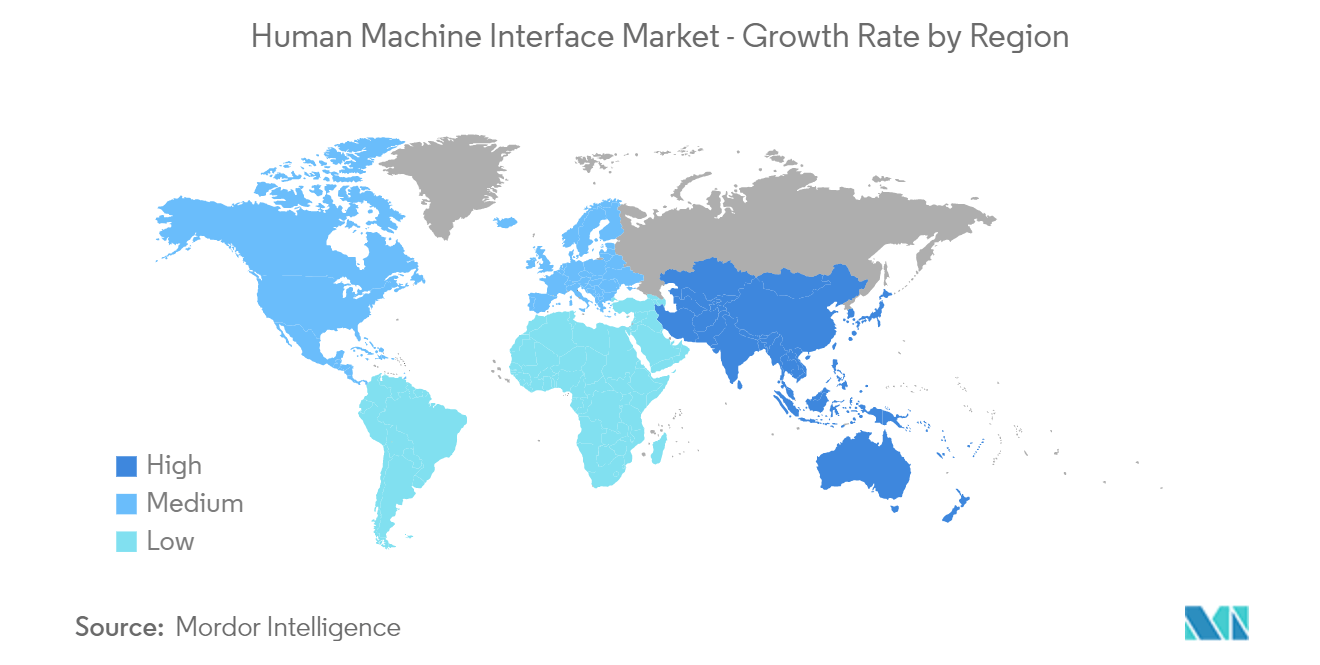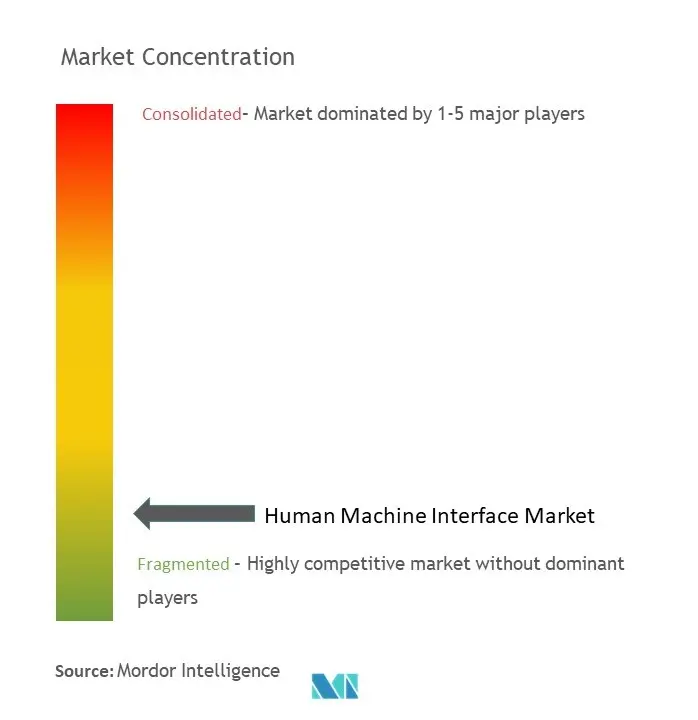Human Machine Interface Market Size

| Study Period | 2019 - 2029 |
| Market Size (2024) | USD 5.02 Billion |
| Market Size (2029) | USD 7.34 Billion |
| CAGR (2024 - 2029) | 7.90 % |
| Fastest Growing Market | Asia Pacific |
| Largest Market | North America |
Major Players
*Disclaimer: Major Players sorted in no particular order |
Human Machine Interface Market Analysis
The HMI Market size is estimated at USD 5.02 billion in 2024, and is expected to reach USD 7.34 billion by 2029, growing at a CAGR of 7.90% during the forecast period (2024-2029).
Features, such as alarm warnings, safe messaging, and improved internal communications, are expected to provide an advantage to a facility regarding security, operations, and production. Newer HMI is expected to reduce operation costs by substituting traditional push buttons, indicator lights, and selectors, lowering the requirement of additional display panels and cables, and further enhancing monitoring of the machines.
- The significance of user interfaces has become increasingly clear over the past years. Apple's products, such as iPod or iPhone, are iconic examples of how intuitive user interfaces have entirely changed the perception of particular product types. The success of Apple's products and other consumer-oriented merchandise shows that standard aesthetics products, graphics, and environment significantly contribute to brand distinction and consistent customer experiences. Many industrial corporations have arrived at the same conclusion and are starting to focus more on the quality of user interfaces in their products. Higher levels of functionality and interactions embedded in the HMI and increasing need of users, such as multi-touch screens and high-quality displays, are expected to drive the market growth.
- Also, HMI is used in various avenues, including manufacturing plants, vending machines, the food and beverage industry, pharmaceuticals, and other utilities. HMIs, in combination with PLCs, are the mainstay of the production line in these industries. The integration of the HMI into manufacturing has vastly improved operations. The HMI enables supervisory control and data acquisition in the entire system, so parameter changes are feasible as the operator chooses. For example, in the manufacturing of metals, HMI might control the method and speed at which a metal is cut and folded. HMI offers improved stock control and replenishment, so fewer trips are required out to vendors.
- According to British Petroleum (BP), global oil consumption reached approximately 94.1 million barrels per day in 2021, an increase of over six percent compared to the previous year. In addition, BP also stated that even after all kinds of financial crises and the coronavirus pandemic, oil consumption has consecutively increased every year since 1998 and is expected to increase more in the future as well, which will, in return, lead to an increase in market numbers for the HMI market.
- The outbreak of COVID-19 influenced global industrial spending significantly over the period, as the non-operational status of various industries deemed non-essential by governments across the world faced huge losses during the initial face, which later went to a steady approach towards regular industrial work as the things went back to normal after governments around the globe removed their respective lockdown phases.
Human Machine Interface Market Trends
This section covers the major market trends shaping the Human Machine Interface Market according to our research experts:
Automotive is Expected to Hold Significant Share
- The constant updation and upgradation of the automobile is a major factor driving the HMI market. For instance, in November 2022, Ford revealed the ultra-high specification Ranger Platinum pickup with exclusive exterior detailing and finishes that enhance the Ranger's already characterful design, matched by a stylish and contemporary leather-trimmed cabin. In addition, Ranger Platinum is available exclusively in five-seat, double cab specification and is powered by Ford's 3.0-liter V6 turbodiesel engine. With the craze for luxury and comfort among the people being the priority, the HMI market is also expected to grow.
- Additionally, according to Organisation Internationale des Constructeurs d'Automobiles (OICA), in year 2021, approimately 80 million motor vehicles were produced globally, which is approx. An increase of 3% compared to the previous year is expected to grow more in the forecasted period. Hence, the market for HMI is also likely to be increased during the period.
- In November 2022, Grupo Antolin, a global supplier of technological solutions for car interiors, introduced an Innovative Upper Trim concept featuring a simple and humanized design for overhead systems. The company announced it as a second of a series of new Grupo Antolin concepts with a precise and single aim to embrace future mobility through Innovation.
- Moreover, in December 2022, Parkopedia announced its new service in all vehicles with BMW Operating Systems 7 and 8, enabling drivers to pay effortlessly for parking in Germany and Austria. Moreover, the company has also planned for further expansion to other European countries in 2023.

Asia-Pacific is Expected to Witness Fastest Growth
- Asia-Pacific is expected to grow at a higher rate than other regions because of the increase in disposable income and population. In this region, China and Japan are considered to be the manufacturing hubs of the equipment required for the human interface machine. Also, in India, manufacturing has emerged as one of the high-growth sectors. The 'Make in India' initiative places India on the global map as a manufacturing hub and significantly recognizes the Indian economy.
- According Indian Brand Equity Foundation (IBEF), in September 2021, the Indian Government approved a PLI scheme worth USD 3.53 billion for the auto and drone industries to boost India's manufacturing capabilities.
- Additionally, according to the India Brand Equity Foundation (IBEF), India has the potential to become a global manufacturing hub. By 2030, the country can add more than USD 500 billion annually to the global economy, which means the market for the HMI will also increase during that period in the region, which will drive the market.
- Moreover, according to the China Association of Automobile Manufacturers (CAAM), the sales of New Energy Vehicles (NEVs) in September 2022 were seen to be around 71 thousand, and from January to September was to be seen approximately 457 thousand, which shows there was a constant demand for NEVs in the market of China, which will result in the sale of HMI products in the region and will drive the market.

Human Machine Interface Industry Overview
The intensity of competitive rivalry in this market is high due to large-scale companies, such as ABB Ltd, Siemens AG, Rockwell Automation Inc., Honeywell International Inc., and Schneider Electric SE. Changing operational and business needs have actuated supported advancements regarding HMI innovation. Evolved forms of HMI, such as high-performance HMIs, touch screens, mobile devices, and more traditional models, are available in the market. The players in this industry are continually developing new product portfolios to gain competitive advantages with mergers and acquisitions, partnerships, and constant innovations.
- August 2022 - ABB India announced that the company has developed and elevated its smart power factory in Nelamangala, Bengaluru, to fulfill the substantial demand for the solutions and energy management technologies offered by the company. Moreover, the company also said that the smart facility harnesses advanced collaborative robotics technology for better human-machine interface (HMI), artificial intelligence (AI), and advanced digitalization technologies to construct a sophisticated, automated, and flexible future-ready factory.
- October 2022 - Schneider Electric released new updates to its EcoStruxure domain architecture and platform, EcoStruxure Power. According to the company, with the integration of ETAP Operator Training Software (eOTS) and EcoStruxure Power Operation energy management software, facility managers can experience a highly realistic Power Operation training environment driven by ETAP's electrical digital twin. Moreover, the integration allows all EcoStruxure Power Operation systems to continuously connect with ETAP Electrical Digital Twin and are designed and validated against contingencies utilizing their familiar EcoStruxure Power Operation human-machine interface.
Human Machine Interface Market Leaders
-
Honeywell International Inc.
-
Siemens AG
-
Rockwell Automation Inc.
-
Schneider Electric SE
-
ABB Ltd
*Disclaimer: Major Players sorted in no particular order

Human Machine Interface Market News
- May 2022 - ABB announced the launch of ABB Ability NGX Hoist Control, which enables mining companies to achieve maximum performance and safety of hoist operations. It is designed with the latest ergonomic and human-factors engineering guidelines. Moreover, it is based on the latest human-machine interface (HMI) insights, offering the most modern and intuitive operator interface.
- January 2022 - Honeywell announced that Repsol selected the company to provide an integrated control and safety system (ICSS) for the foremost advanced biofuel production plant to be built in Spain. Moreover, the company stated that the new facility would utilize a variety of distributed control systems (DCS), emergency shutdown (ESD), fire and gas (F&G), and human-machine interface (HMI) solutions from Honeywell to execute efficient, sustainable, and low-emission operations.
Human Machine Interface Market Report - Table of Contents
1. INTRODUCTION
- 1.1 Study Assumptions and Market Definition
- 1.2 Scope of the Study
2. RESEARCH METHODOLOGY
3. EXECUTIVE SUMMARY
4. MARKET INSIGHTS
- 4.1 Market Overview (includes impact of COVID-19 on the market)
- 4.2 Industry Value Chain Analysis
-
4.3 Industry Attractiveness - Porter's Five Forces Analysis
- 4.3.1 Bargaining Power of Suppliers
- 4.3.2 Bargaining Power of Consumers
- 4.3.3 Threat of New Entrants
- 4.3.4 Threat of Substitute Products
- 4.3.5 Intensity of Competitive Rivalry
- 4.4 Technology Snapshot
5. MARKET DYNAMICS
-
5.1 Market Drivers
- 5.1.1 Shift toward Industry 4.0 and Adoption of IoT
- 5.1.2 Increasing Focus on Developing Manufacturing Processes
-
5.2 Market Restraints
- 5.2.1 Higher Initial Cost and Lack of Skilled Operators
6. INDUSTRY POLICIES
7. MARKET SEGMENTATION
-
7.1 By Type of Offering
- 7.1.1 Hardware
- 7.1.2 Software
- 7.1.3 Services
-
7.2 By End User Industry
- 7.2.1 Automotive
- 7.2.2 Food and Beverage
- 7.2.3 Packaging
- 7.2.4 Pharmaceutical
- 7.2.5 Oil and Gas
- 7.2.6 Metal and Mining
- 7.2.7 Other End Users
-
7.3 Geography
- 7.3.1 North America
- 7.3.1.1 United States
- 7.3.1.2 Canada
- 7.3.2 Europe
- 7.3.2.1 United Kingdom
- 7.3.2.2 Germany
- 7.3.2.3 France
- 7.3.2.4 Rest of Europe
- 7.3.3 Asia Pacific
- 7.3.3.1 China
- 7.3.3.2 Japan
- 7.3.3.3 India
- 7.3.3.4 Rest of Asia Pacific
- 7.3.4 Latin America
- 7.3.4.1 Brazil
- 7.3.4.2 Argentina
- 7.3.4.3 Mexico
- 7.3.4.4 Rest of Latin America
- 7.3.5 Middle East and Africa
- 7.3.5.1 Saudi Arabia
- 7.3.5.2 United Arab Emirates
- 7.3.5.3 Rest of Middle East and Africa
8. COMPETITIVE LANDSCAPE
-
8.1 Company Profiles
- 8.1.1 ABB Ltd
- 8.1.2 Honeywell International Inc.
- 8.1.3 Rockwell Automation Inc.
- 8.1.4 Mitsubishi Electric Corporation
- 8.1.5 Schneider Electric SE
- 8.1.6 Emerson Electric Co.
- 8.1.7 General Electric Co.
- 8.1.8 Texas Instruments Inc.
- 8.1.9 Yokogawa Electric Corporation
- 8.1.10 Siemens AG
- 8.1.11 Robert Bosch GmbH
- 8.1.12 Eaton Corporation
- *List Not Exhaustive
9. INVESTMENT ANALYSIS
10. FUTURE OF THE MARKET
** Subject To AvailablityHuman Machine Interface Industry Segmentation
Human-machine interface (HMI) is used to optimize a process by centralizing and digitizing for the user, where the operators can see important pieces of information in different forms of graphs, chatbots, or digital assistance. The adoption of automation in various end-user industries, like food and beverages, packaging, etc., to increase operational efficiencies is a significant trend catalyzing the expansion of the human-machine interface market. The increasing number of industrial applications and automation in the United States is expected to propel the utilization of human-machine interfaces in the country, helping the industry grow.
The Human Machine Interface Market is segmented by Type of Offering (Hardware, Software, and Service), End-User Industry (Automotive, Food and Beverage, Packaging, Pharmaceutical, Oil and Gas, Metal and Mining), and Geography (North America, Europe, Asia Pacific, Latin America, MEA). The market sizes and forecasts are provided in terms of value (USD million) for all the above segments.
| By Type of Offering | Hardware | |
| Software | ||
| Services | ||
| By End User Industry | Automotive | |
| Food and Beverage | ||
| Packaging | ||
| Pharmaceutical | ||
| Oil and Gas | ||
| Metal and Mining | ||
| Other End Users | ||
| Geography | North America | United States |
| Canada | ||
| Geography | Europe | United Kingdom |
| Germany | ||
| France | ||
| Rest of Europe | ||
| Geography | Asia Pacific | China |
| Japan | ||
| India | ||
| Rest of Asia Pacific | ||
| Geography | Latin America | Brazil |
| Argentina | ||
| Mexico | ||
| Rest of Latin America | ||
| Geography | Middle East and Africa | Saudi Arabia |
| United Arab Emirates | ||
| Rest of Middle East and Africa |
Human Machine Interface Market Research FAQs
How big is the HMI Market?
The HMI Market size is expected to reach USD 5.02 billion in 2024 and grow at a CAGR of 7.90% to reach USD 7.34 billion by 2029.
What is the current HMI Market size?
In 2024, the HMI Market size is expected to reach USD 5.02 billion.
Who are the key players in HMI Market?
Honeywell International Inc., Siemens AG, Rockwell Automation Inc., Schneider Electric SE and ABB Ltd are the major companies operating in the HMI Market.
Which is the fastest growing region in HMI Market?
Asia Pacific is estimated to grow at the highest CAGR over the forecast period (2024-2029).
Which region has the biggest share in HMI Market?
In 2024, the North America accounts for the largest market share in HMI Market.
What years does this HMI Market cover, and what was the market size in 2023?
In 2023, the HMI Market size was estimated at USD 4.65 billion. The report covers the HMI Market historical market size for years: 2019, 2020, 2021, 2022 and 2023. The report also forecasts the HMI Market size for years: 2024, 2025, 2026, 2027, 2028 and 2029.
Human Machine Interface Industry Report
Statistics for the 2024 Human Machine Interface market share, size and revenue growth rate, created by Mordor Intelligence™ Industry Reports. Human Machine Interface analysis includes a market forecast outlook to 2029 and historical overview. Get a sample of this industry analysis as a free report PDF download.



